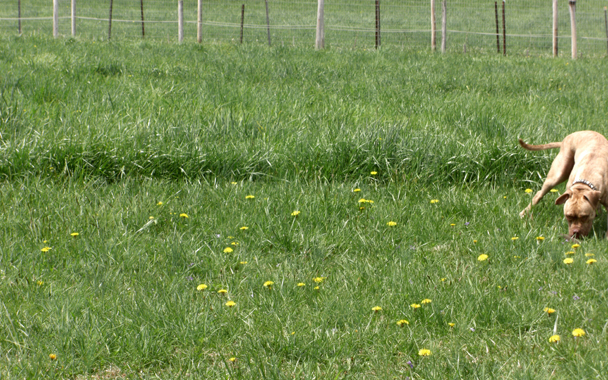First off, remember that watercress that I told you about back in March? Its time has arrived. From a few leaves hiding in the winter woods, it has grown into a forest of green that eclipses any sign of the spring water that trickles gently through its root system. Last weekend, I harvested handful over handful to eat in salads, soups, and sautés. (Just be sure not to pick watercress downstream from a farm if you want to eat it raw.) I even blanched some to freeze and use later, like frozen spinach. The cress will only be around for a few more weeks. Also, those ramps that my dog sniffed out? I ate them. All of them.
So here we are in June, with a whole new menu of wild greens to choose from. It started with the baby dandelion, which was delicious for about a week before the fluffy yellow pom-pom flowers shot up, turning the tender greens leathery and too bitter to swallow. This was the point when most homeowners and lawn aficionados reached for the herbicides and start spouting off four-letter words, like weed!
But one man’s weed is another man’s wine. (And this time I mean that quite literally.)
I’ve made dandelion wine once before. The end result didn’t taste too bad, but the fermented liquid was overly sweetened when it went into the bottle. If you’ve ever made beer at home, you’ll know that over-sweetening a brew at bottling does not make it sweet—it makes it dangerous. Four of my seven bottles of dandelion wine exploded like alcoholic grenades, sending chunks of glass all over the place. This year, I’m going to make a still dandelion wine instead of a carbonated one, hopefully avoiding any more explosions.
To make dandelion wine, you’ll need to start with about a gallon of dandelion flowers. That’s more than you think: It took me a good hour and a half to pick them all, and by the end my hands were stained bright yellow from their pollen. After picking, give the flowers a quick rinse and steep them in a gallon of hot water for several hours. The resulting tea will be the bittering agent for the wine (like hops are for beer).
Next, dissolve about 2 1/2 pounds of brown sugar in another gallon of water and combine it with your dandelion tea. Add citrus juice to taste (I used 4 oranges and 5 lemons). Add 1 package wine yeast and ferment until there’s no more activity from the yeast. Then strain and bottle.
Most dandelion wine recipes will encourage you to store the wine in the bottle for at least six months as it greatly improves with age. The one bottle I had left from my 2008 batch was refreshing and balanced when I tasted it last week. And I dressed in full-on bomb-squad gear when opening the bottle, just in case.




 Pinterest
Pinterest


